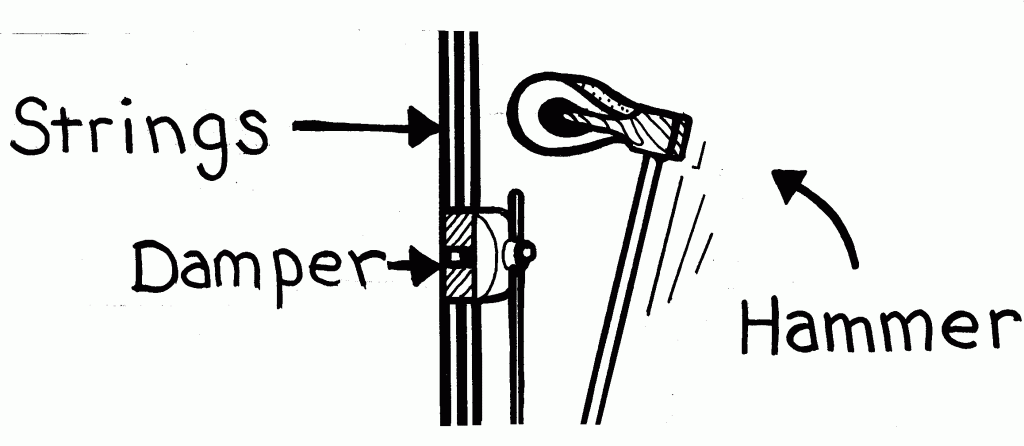“What are those pedals for?” – As a pianist, I get asked about pedals quite often!
Its actually somewhat surprising how far some piano players can get without knowing what all of the pedals do. They all have very specific applications, and produce very distinct results. Some we use more than others, and they sometimes change from piano to piano!
There are often three pedals on a piano. Lets start by taking a look at the most common pedal – The sustain pedal.
This is the pedal on the far right. It is called the sustain pedal, but is sometimes referred to as the damper pedal. They were added to the piano in the mid – 1700s. Before you can understand how the sustain pedal works, it helps to know how a piano works in the first place.
When you press a key, a damper (piece of felt resting on the string) is lifted, and a hammer strikes the string creating sound. When you take your finger off of the key, the damper is immediately placed back on the string to mute, or end, the sound.
When you hold down the sustain pedal, it holds up all of the dampers on the piano, letting all keys you press ring out freely until they naturally decay, or you take your foot off of the sustain pedal.
This pedal is used to create a legato effect, or prolong the length of each note. It helps blend individual notes together to create a nice soundscape with an emphasis on the harmonic texture. It is a tool in a pianists toolbox that is very hard to do without. Next time you’re sitting down at a piano… give it a try!
The far left pedal is often referred to as the soft pedal, or the una chorda. The soft pedal was invented around the same time as the sustain pedal, but was the first piano pedal to be invented to alter the piano’s sound. The name una chorda is a latin abbreviation which means one string. This will make sense shortly.
Once again, some knowledge about how pianos work helps to understand what is happening when you press each of these pedals. Most notes on a piano are actually made up of 3 strings tuned to the same pitch. When you press one key, you are often striking three strings with the same hammer. This is to give a louder, and fuller sound.
The soft pedal changes the position of the hammer, causing it to strike only one of the 3 strings.Hence the term: una chorda. This results in a softer, and quieter sound.
In upright pianos it actually moves all of the hammers slightly closer to the strings. This keeps the hammers from being able to build up enough speed before striking the strings resulting in a quieter sound.
This pedal is used when you are playing a softer passage in a song, and you need a very delicate soft and quiet tone. I have had many teachers complain about this pedal, claiming that one’s technique should be capable enough to control volume equally as well as a pedal!
The middle pedal is called the sostenuto pedal. It was a relatively late addition to the piano pedal family having been invented in 1844. It is the least common piano to be used, and is found primarily on American grand pianos.
It is similar to the sustain pedal, however it only effects notes that have been played and held while the pedal was pressed. If you play a note and hold your finger down on the key while you press the sostenuto pedal, that note will be sustained. All other notes, will remain unaffected by this pedal.
This pedal is rarely used, and only usually appears in the music from the 20th century.
That being said, if you are the proud owner of an upright piano, your favourite (or your neighbour’s favourite) pedal is the middle pedal. The practice pedal! This pedal drops a strip of felt between the hammers and the strings that absorbs a large amount of energy, and drastically decreases the volume of each note. The tone is heavily affected in a negative way, but it is useful when practicing when noise is a concern.

You should now have at least somewhat of a better understanding of your piano pedals! However, these things are best explained when sitting in front of a piano. If you have any questions, as your piano teacher to demonstrate on an acoustic piano, or drop by a piano store and experiment!
Scientists Discovered Something Amazing About Musicians Brains – Merriam Music – Toronto’s Top Piano Store & Music School
The list of benefits from learning a musical instrument is constantly growing. A recent study conducted at the University of Texas showed that musicians may have far more well-developed long-term memories compared to non-musicians. Weve known that learning a musical instrument has a significant positive impact on short term memory, linguistic abilities, and spatiotemporal faculties, but this study has found the first strong evidence in regards to long-term memory. Via merriammusic.com
Surgeons and Pigs Feet Prove Music Increases Productivity.
Researchers asked15 surgeons to sew up incisions made in dead pigs feet, because theyre most similar to human skin (nice), in their lab. The surgeons had to carry out two identical wound repairs using layered stitches, on two consecutive days.Some had their preferred music on during their first day in the lab some had it on for the second. Music has a great way of getting our mind and body working together in a rhythm. Surgeons and Pigs Feet Prove Music Increases Productivity.



